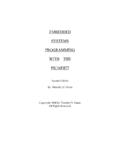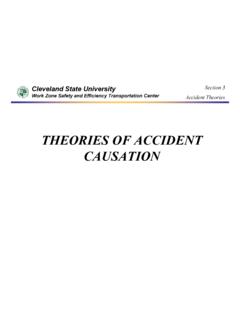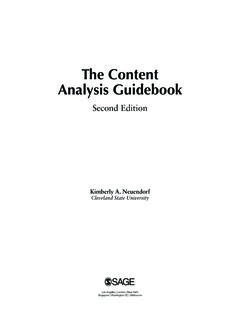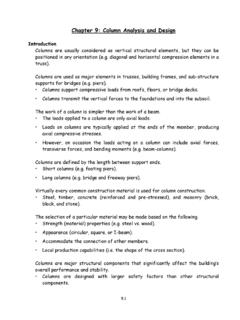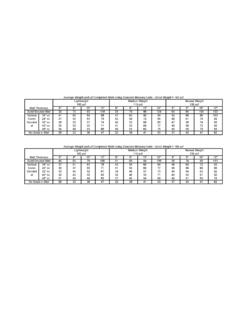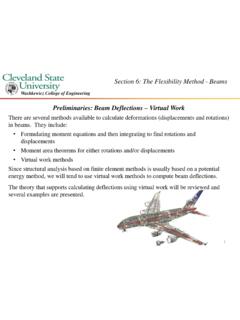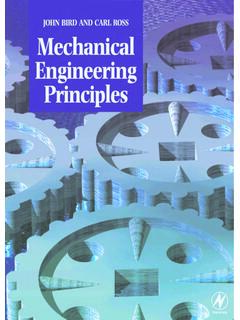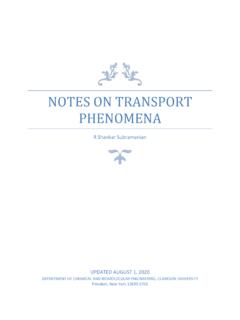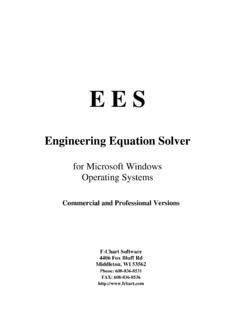Transcription of Introduction to Ordinary and Partial Differential Equations
1 Introduction to Ordinary and Partial Differential Equations One Semester Course Shawn D. Ryan, Department of Mathematics Cleveland State Univeristy Copyright c 2010-2018 Dr. Shawn D. Ryan, Assistant Professor, Department of Mathe- matics, Cleveland State University P UBLISHED O NLINE. Special thanks to Mathias Legrand with modifications by for creating and modifying the template used for these lecture notes. Also, thank you to Vivek Srikrishnan (Penn State) for providing the original framework and outlines for certain topics in this textbook. In addition, thank you to Zach Tseng and other faculty members in the Penn State Department of Mathematics for encouraging me to write these lecture notes and continuing to use them. Licensed under the Creative Commons Attribution-NonCommercial Unported License (the License ).
2 You may not use this file except in compliance with the License. You may obtain a copy of the License at by- Unless required by applicable law or agreed to in writing, software distributed under the License is distributed on an AS IS BASIS , WITHOUT WARRANTIES OR CONDI - TIONS OF ANY KIND , either express or implied. See the License for the specific language governing permissions and limitations under the License. First published online, January 2010. Contents I Classification of Differential Equations 1 Introduction .. 11. Introduction 11. Some Basic Mathematical Models; Direction Fields 11. Solutions of Some Differential Equations 14. Classifications of Differential Equations 16. II First Order Differential Equations 2 Solution Methods For First Order Equations .. 21.
3 Linear Equations ; Method of Integrating Factors 21. REVIEW: Integration By Parts .. 24. Separable Equations 25. Modeling With First Order Equations 28. Existence and Uniqueness 34. Linear Equations .. 35. Nonlinear Equations .. 36. Summary .. 39. Autonomous Equations with Population Dynamics 39. Autonomous Equations .. 39. Populations .. 40. Exact Equations 41. Multivariable Differentiation .. 41. Exact Equations .. 42. III Linear Higher Order Equations 3 Solutions to Second Order Linear Equations .. 49. Second Order Linear Differential Equations 49. Basic Concepts .. 49. Homogeneous Equations With Constant Coefficients .. 51. Solutions of Linear Homogeneous Equations and the Wronskian 51. Existence and Uniqueness .. 51. Wronskian .. 52. Linear Independence .. 55. More On The Wronskian.
4 56. Abel's Theorem .. 56. Complex Roots of the Characteristic Equation 58. Review Real, Distinct Roots .. 58. Complex Roots .. 59. Repeated Roots of the Characteristic Equation and Reduction of Or- der 62. Repeated Roots .. 62. Reduction of Order .. 65. Nonhomogeneous Equations with Constant Coefficients 67. Nonhomogeneous Equations .. 67. Undetermined Coefficients .. 68. The Basic Functions .. 69. Products .. 72. Sums .. 74. Method of Undetermined Coefficients .. 77. Mechanical and Electrical Vibrations 79. Applications .. 79. Free, Undamped Motion .. 81. Free, Damped Motion .. 84. Forced Vibrations 88. Forced, Undamped Motion .. 88. 4 Higher Order Linear Equations .. 93. General Theory for nth Order Linear Equations 93. Homogeneous Equations with Constant Coefficients 94.
5 IV Solutions of ODE with Transforms 5 Laplace Transforms .. 99. Definition of the Laplace Transform 99. The Definition .. 99. Laplace Transforms .. 102. Initial Value Problems .. 102. Inverse Laplace Transform .. 103. Laplace Transform for Derivatives 109. Step Functions 114. Step Functions .. 114. Laplace Transform .. 115. Differential Equations With Discontinuous Forcing Functions 119. Inverse Step Functions .. 119. Solving IVPs with Discontinuous Forcing Functions .. 122. Dirac Delta and the Laplace Transform 125. The Dirac Delta .. 125. Laplace Transform of the Dirac Delta .. 126. V Systems of Differential Equations 6 Systems of Linear Differential Equations .. 133. Systems of Differential Equations 133. Review of Matrices 134. Systems of Equations .. 134. Linear Algebra.
6 135. Linear Independence, Eigenvalues and Eigenvectors 138. Eigenvalues and Eigenvectors .. 139. Homogeneous Linear Systems with Constant Coefficients 144. Solutions to Systems of Differential Equations .. 144. The Phase Plane .. 145. Real, Distinct Eigenvalues .. 146. Complex Eigenvalues 153. Repeated Eigenvalues 159. A Complete Eigenvalue .. 160. A Defective Eigenvalue .. 160. 7 Nonlinear Systems of Differential Equations .. 167. Phase Portrait Review 167. Case I: Real Unequal Eigenvalues of the Same Sign .. 168. Case II: Real Eigenvalues of Opposite Signs .. 169. Case III: Repeated Eigenvalues .. 169. Case IV: Complex Eigenvalues .. 170. Case V: Pure Imaginary Eigenvalues .. 170. Summary and Observations .. 172. Autonomous Systems and Stability 172. Stability and Instability.
7 173. Locally Linear Systems 174. Introduction to Nonlinear Systems .. 174. Linearization around Critical Points .. 174. Predator-Prey Equations 176. VI Partial Differential Equations 8 Introduction to Partial Differential Equations .. 183. Two-Point Boundary Value Problems and Eigenfunctions 183. Boundary Conditions .. 183. Eigenvalue Problems .. 185. Fourier Series 187. The Euler-Fourier Formula .. 188. Convergence of Fourier Series 192. Convergence of Fourier Series .. 194. Even and Odd Functions 196. Fourier Sine Series .. 197. Fourier Cosine Series .. 199. The Heat Equation 201. Derivation of the Heat Equation .. 202. Separation of Variables and Heat Equation IVPs 203. Initial Value Problems .. 203. Separation of Variables .. 204. Neumann Boundary Conditions .. 207.
8 Other Boundary Conditions .. 208. Heat Equation Problems 208. Examples .. 210. Other Boundary Conditions 212. Mixed Homogeneous Boundary Conditions .. 212. Nonhomogeneous Dirichlet Conditions .. 213. Other Boundary Conditions .. 216. The Wave Equation 216. Derivation of the Wave Equation .. 216. The Homogeneous Dirichlet Problem .. 218. Examples .. 219. Laplace's Equation 221. Dirichlet Problem for a Rectangle .. 221. Dirichlet Problem For A Circle .. 222. Example 1 .. 224. Example 2 .. 225. I. Classification of Differential Equations 1 Introduction .. 11. Introduction Some Basic Mathematical Models; Direction Fields Solutions of Some Differential Equations Classifications of Differential Equations 1. Introduction Introduction This set of lecture notes was built from a one semester course on the Introduction to Ordinary and Differential Equations at Penn State University from 2010-2014.
9 Our main focus is to develop mathematical intuition for solving real world problems while developing our tool box of useful methods. Topics in this course are derived from five principle subjects in Mathematics (i) First Order Equations (Ch. 2). (ii) Second Order Linear Equations (Ch. 3). (iii) Higher Order Linear Equations (Ch. 4). (iv) Laplace Transforms (Ch. 5). (v) Systems of Linear Equations (Ch. 6). (vi) Nonlinear Differential Equations and Stability (Ch. 7). (vii) Partial Differential Equations and Fourier Series (Ch. 8). Each class individually goes deeper into the subject, but we will cover the basic tools needed to handle problems arising in physics, materials sciences, and the life sciences. Here we focus on the development of the solution methods for solving those problems.
10 Some Basic Mathematical Models; Direction Fields 12 Chapter 1. Introduction Definition A Differential equation is an equation containing derivatives. Definition A Differential equation that describes some physical process is often called a mathematical model Example (Falling Object). v (+). mg Consider an object falling from the sky. From Newton's Second Law we have dv F = ma = m ( ). dt When we consider the forces from the free body diagram we also have F = mg v ( ). where is the drag coefficient. Combining the two dv m = mg v ( ). dt Suppose m = 10kg and = 2kg/s. Then we have dv v = ( ). dt 5. It looks like the direction field tends towards v = 49m/s. We plot the direction field by plugging in the values for v and t and letting dv/dt be the slope of a line at that point.
